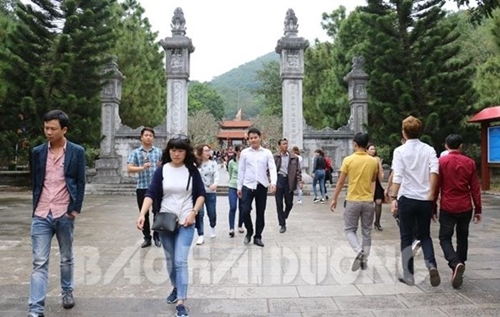Number of visitor scaling up over years
During 2010 – 2014, the number of tourists to Hai Duong just surpassed 2 million on an average annual basis. The figure increased to 3.12 million in 2015 and to 3.95 million in 2018.
In the first half of 2019, about 2.18 million holiday-makers chose the province for their vacations, up 17.4 percent on year. This meant that there is a great possibility that Hai Duong will achieve an important landmark of welcome 4 million tourists this year. With this trend, the ambitious goal of 4.65 million visitors set for 2020 is likely to be achieved by the end of this year.
    |
 |
|
In the first half of 2019, the number of visitors to Con Son - Kiep Bac increased by over 10 percent against the same period last year. Source: baohaiduong.vn |
To make such figures a reality, a significant workload is needed to be done, as the province is yet to fully tap its potential. There is no large-scale tourism site that integrates a wide range of services for visitors from sightseeing, accommodation, shopping to entertainment. There is also a shortage of diverse tourism products with high quality at the moment. The shortcomings are attributable to the lack of big investors in Hai Duong’s tourism sector and state funding falling short of demand.
Currently, Hai Duong is working with other localities in the Northern key economic region to build inter-provincial tourism routes, while investing in improving its popular destinations and offering more services at traditional craft villages.
It is calling for investment in developing services in the Con Son - Kiep Bac relic site, and in building a Vietnamese village resort, a conservation museum of water rice paddies in Thanh Ha district, the Dao Co (Stork Island) community-based tourism site in Thanh Mien district, and the Ben Tam eco-tourism site in Chi Linh city.
In the coming time, the local tourism sector prioritises the organization of communications campaigns and tourism promotion programs in Vietnam and abroad. It will also seek approval from the provincial People’s Committee for a project on developing smart tourism in Hai Duong for 2019 – 2025.
Significant tourism potential
With its beautiful landscape together with rich cultural value plus a favorable geographical location and convenient transport system, Hai Duong aims to turn tourism into an economic spearhead by 2020.
Formerly called “Thanh Dong” – meaning the city to the East of Thang Long imperial citadel, the province has been well-known for its rich culture, both tangible and intangible, which is typical of the Red River Delta. The province was a cradle of cheo (traditional opera), ca tru (ceremonial singing), chau van (spiritual singing) and water puppetry.
The locality boasts 2,207 historical and cultural relic sites, including 144 ranked as national relic sites and four included in the list of special national relic sites.
Among the four special national relic sites, Con Son - Kiep Bac is arguably the most well-known one. The site is closely associated with the lives and careers of outstanding national hero Tran Hung Dao, the great writer Nguyen Trai, and the great teacher Chu Van An.
Meanwhile, Mao Dien Temple of Literature is the second largest of its kind in Vietnam after the temple in Hanoi. Built during the early period of the Later Le Dynasty in Vinh Tuy commune, Binh Giang district in the 15th century, it was later moved to Cam Dien commune, Cam Giang during the Tay Son Dynasty (1788 – 1802). The temple is a place where worshipers come to pay homage to Confucius as well as some 600 Confucian scholars of the province that have been honored over more than 500 years.
Hai Duong is also famous for local specialties such as glutinous rice, lychees, green bean cakes, and gai cakes (glutinous rice cake dyed black with a concoction of pinnate leaves). Local craft villages like Kinh Chu stone carving village, Dong Giao wood carving village, Chau Khe jewelry village, and Cay and Chu Dao ceramic villages also preserve their traditional crafts which have been passed down many generations.
Source: VNA